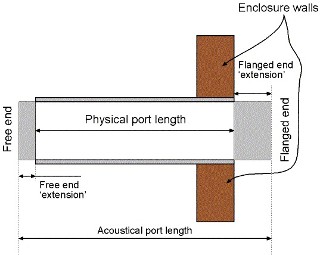Hi there.
1) MY OPINION is a port opening should be no closer to a wall than the diameter of the port.
2) There is no functional differenece between any properly designed port. Some sound better than others depending on the application. For subwoofers, it really doesn't matter. JL and other companies usually recomend slot ports because it is easier to build a large port using slot techniques than having to bend a round tube inside the enclosure. And it is never too cynical to assume that any "recomendation" from a manufacturer is at least partly designed to favor their products. 
-------------
Support the12volt.comSedate wrote:
is it a cynical conclusion to believe JL Audio does this to sell *thier* boxes?
Noooo... Never. No audio company has ever mislead a customer.
Paul
Re: what DYohn said was his OPINION on area inside the box past the port end: I thought it was an absolute MUST to allow the diameter of the port at the end. But as I looked again at the explanation in WinISD on this subject, it appears that IT IS necessary to leave SOME space at the end....as you will see when you look at the pic below....BUT you don't really know how much you will need to leave (unless you do a complicated "end correction" calculation). Thus, the port diameter acting as a safety net for the necessary room that you DO have to allow.

Here is what the (Swedish, to explain the rough English) author of WinISD says about the characteristics of a port's length:
Acoustical length
First, we need to discuss what is the idea behind port, and how it works. Basically, port forms a mass-spring resonance circuit with enclosure volume compliance. Helmholtz was first to discover such a resonator, hence it was named after him. Mass in port resonates with compliance of box air. By tuning the enclosure, we chose mass in port, so that resonates at desired frequency. As our port will have some area, we can calculate, how long this "tube" should be to have desired mass. This length is so called "acoustical length" of our port.
Physical length
Unfortunately, effect of the port doesn't stop at the end of our port. Moving mass extends somewhat beyond of the port.
As you can see in the illustration, the acoustical port extends past the physical port. End correction is calculated in port length design calculators, so you don't have to make physical changes to any port lengths yourself (...if you know of a calculator that doesn't take end correction into consideration, let me know...). This shows that a necessary amount of space has to be maintained at BOTH ends of a port.
The other reason, of course, is to allow a sufficient amount of air to enter the port. If the free end is shallower than the diameter of the port, the air flow will suffer.
As far as the recommendation for the slot port, IMO: JL is conscious of the need to allow enough port opening so that port noise won't ruin the sound of their subwoofer. It is far easier to design a slot port to fit the enclosure than it is to put a round port OF THE SAME OPENING SIZE on the face of the box. Look at this example:
You often hear of 4" round port being of about the largest size used on a sub box, and for consideration of length, only one being used. 4" in itself, being round, takes up a lot of space. Using pi R^2 to find opening size, you get 12.5".
Now use a simple slot port of 12" X 2 1/8 " along one side of the box....very easy to fit. At 25" of opening it's twice the size of the 4" port...and much more apt to be quiet when the db's are high.
If you're using a box-building design program or group of calculators, be sure to include verifying minimum port noise when designing the port.
-------------
Build the box so that it performs well in the worst case scenario and, in return, it will reward you at all times.

